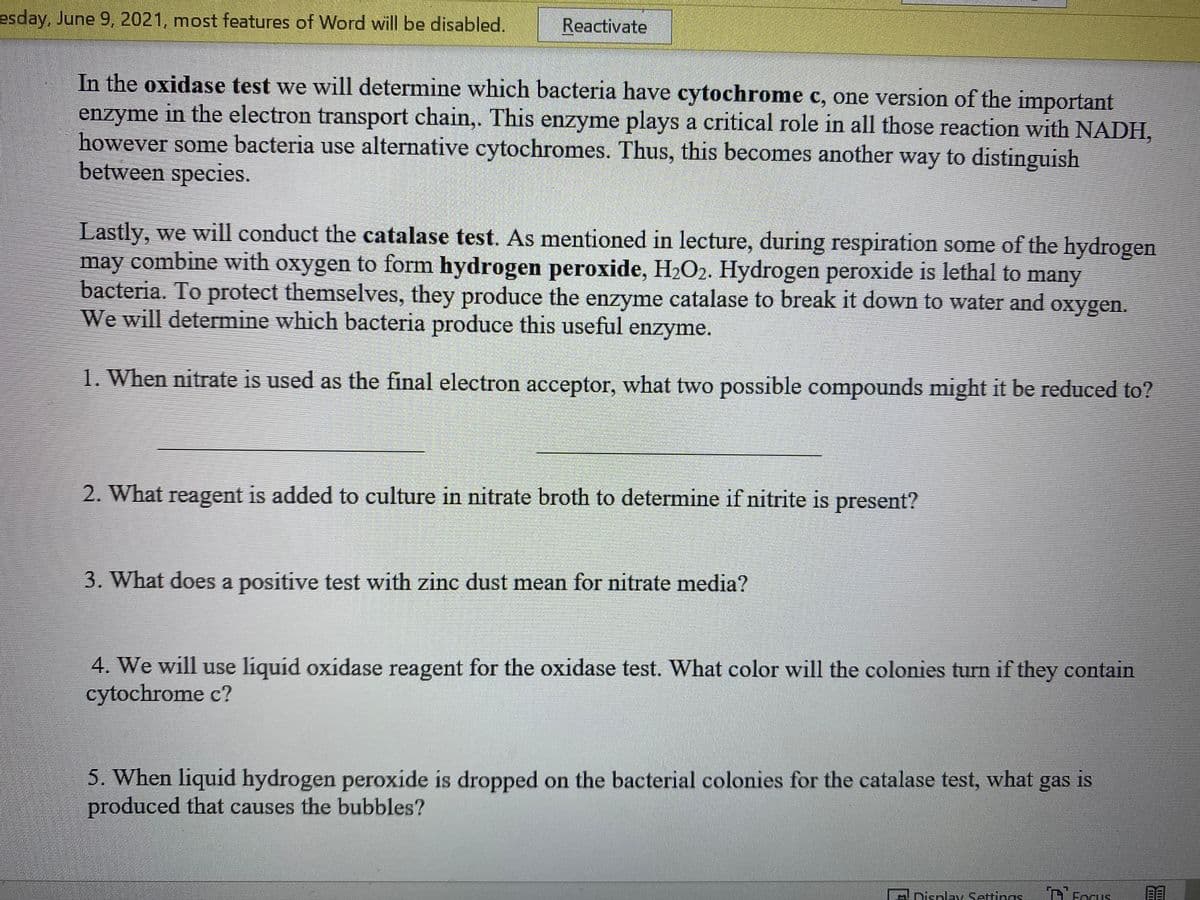Biochemistry
6th Edition
ISBN:9781305577206
Author:Reginald H. Garrett, Charles M. Grisham
Publisher:Reginald H. Garrett, Charles M. Grisham
Chapter21: Photosynthesis
Section: Chapter Questions
Problem 5P: The Relative Efficiency of ATP Synthesis in Noncyclic versus Cyclic Photophosphorylation If...
Related questions
Question
We will use liquid oxidase reagent for the oxidase test. What color will the colonies turn if they contain cytochrome c?

Transcribed Image Text:esday, June 9, 2021, most features of Word will be disabled.
Reactivate
In the oxidase test we will determine which bacteria have cytochrome c, one version of the important
enzyme in the electron transport chain,. This enzyme plays a critical role in all those reaction with NADH,
however some bacteria use alternative cytochromes. Thus, this becomes another way to distinguish
between species.
Lastly, we will conduct the catalase test. As mentioned in lecture, during respiration some of the hydrogen
may combine with oxygen to form hydrogen peroxide, H2O2. Hydrogen peroxide is lethal to many
bacteria. To protect themselves, they produce the enzyme catalase to break it down to water and oxygen.
We will determine which bacteria produce this useful enzyme.
1. When nitrate is used as the final electron acceptor, what two possible compounds might it be reduced to?
2. What reagent is added to culture in nitrate broth to determine if nitrite is present?
3. What does a positive test with zinc dust mean for nitrate media?
4. We will use liquid oxidase reagent for the oxidase test. What color will the colonies turn if they contain
cytochrome c?
5. When liquid hydrogen peroxide is dropped on the bacterial colonies for the catalase test, what gas is
produced that causes the bubbles?
A Display Settings
Focus
Expert Solution
This question has been solved!
Explore an expertly crafted, step-by-step solution for a thorough understanding of key concepts.
This is a popular solution!
Trending now
This is a popular solution!
Step by step
Solved in 2 steps

Knowledge Booster
Learn more about
Need a deep-dive on the concept behind this application? Look no further. Learn more about this topic, biology and related others by exploring similar questions and additional content below.Recommended textbooks for you

Biochemistry
Biochemistry
ISBN:
9781305577206
Author:
Reginald H. Garrett, Charles M. Grisham
Publisher:
Cengage Learning

Anatomy & Physiology
Biology
ISBN:
9781938168130
Author:
Kelly A. Young, James A. Wise, Peter DeSaix, Dean H. Kruse, Brandon Poe, Eddie Johnson, Jody E. Johnson, Oksana Korol, J. Gordon Betts, Mark Womble
Publisher:
OpenStax College

Biochemistry
Biochemistry
ISBN:
9781305577206
Author:
Reginald H. Garrett, Charles M. Grisham
Publisher:
Cengage Learning

Anatomy & Physiology
Biology
ISBN:
9781938168130
Author:
Kelly A. Young, James A. Wise, Peter DeSaix, Dean H. Kruse, Brandon Poe, Eddie Johnson, Jody E. Johnson, Oksana Korol, J. Gordon Betts, Mark Womble
Publisher:
OpenStax College